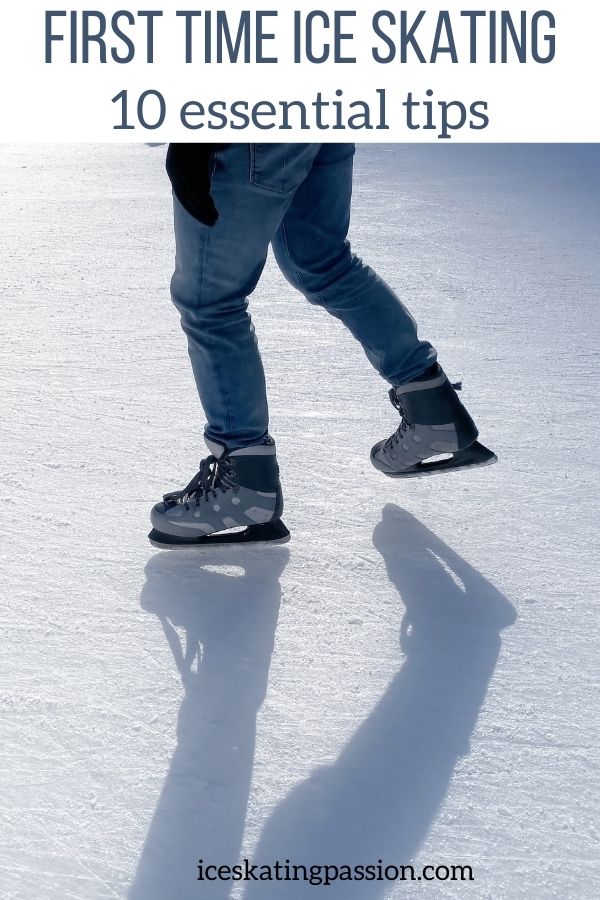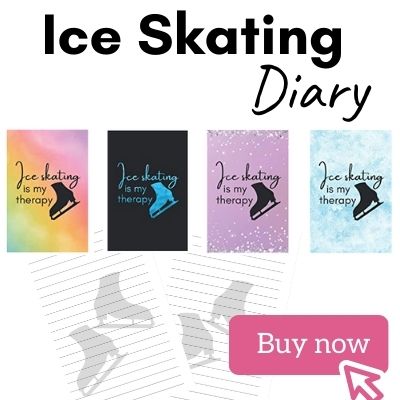Going ice skating for the first time? Great this is a wonderful activity with lots of benefits.
But as a beginner, the first steps on the ice can be dauntin. How to ice skate?
I have gathered below my top "First time ice skating tips" for you to have a wonderful time and feel in control as much as possible.
Have fun!

This article contains affiliate links. If you purchase using my link, I get a commission at no extra cost to you (learn more).
#1 - Dress for comfort and safety
The way you dress will have an impact on your first ice skating experience. Your clothes must ensure comfort, warmth, safety.
Below are the essential dos and don'ts of ice skating beginner clothes:
- DON'T wear thick socks - this is the #1 mistake people make because so many websites recommend it... and people are afraid that their feet will get cold. But thick socks will not be breathable and will limit your movements. At the end your feet will get colder. Plus, the thickness hinders your balance.
- DO wear socks that reach above the boot to avoid friction and blisters
- DO wear layers - depending on how fast you are going to move you might need more or less warmth - wear layers so that you can easily remove or add depending on how you feel
- DON'T wear a jean as a beginner - they limit movements and if the ice is wet and you fall, it will become very uncomfortable
- DO wear gloves - they will keep you warm and protect your hands if you fall
- DON'T wear a hanging scarf or a hat that does not hold well to your head - do not wear anything loose that can fall and make somebody else fall or that can get stuck in another piece of clothing and be dangerous for you.
#2 - Choose the right skates - essential First time ice skating tips
Now, let's talk ice skate tips.
2a - Hockey style vs figure skating styles
If you have a choice, figure skating skates (with the toes at the front) are considered easier to first learn to skate because of the longer blade.
Find out more about the differences
2b - Choose the right size of skates
Finding the right size of skates is critical. Here are some tips for your first-time ice skating:
- If they are too small your toes and feet will be sore quickly and you will only be thinking of removing them making the experience not fun
- If they are too big, you won't have proper ankle support and will increase risk of injury
In theory, it is your normal size or larger. Try them to find the most appropriate. They should feel snug. But they should not feel too tight. You must be able to move your toes (so that they don't go numb).
Learn more on my article about the best hockey skates for adults and teens.

#3 - Lace your skate for comfort and ankle support
Once you have the right size of skates, it is as essential to lace them / fasten them up properly.
The same objectives apply:
- you don't want your feet to feel compressed and your toes not to move
- you do want your ankle to be supported.
If you have proper skates with laces:
- Sit down on a bench,
- Leave your heel on the ground and bend your back,
- Don't lace too tight at the bottom,
- Make a knot in the middle to hold the ankle in place,
- Secure the ankle firmly but make sure you can still bend your ankle,
- Finish with a secure knot that will not become unlaced during skating,
- Tuck the ends into the top of your skates or fold your sock around the top of the boot (if you have long socks) to hold everything in place
Learn more on my article about how to lace your ice skates.

#4 - Start slowly
4a - Warm up
I always think it is a good idea to warm up before any kind of activity.
People do feel embarrassed doing it when they are beginners, but this is one of the best ways to reduce the risk of injury.
Make sure to move your back, neck and shoulders.
Warm up and stretch your legs
4b - Check direction and breathe
Even before entering the rink, take your time. Look at the other skaters. Make sure you enter the rink to skate in the same direction.
Take a deep breath to relax before stepping on the ice
4c - At first, stay close to the barrier
Be patient. At first, stay close to the barrier to feel safer and be able to catch it if needed.
Get a feel for the ice and how your body react to movements.
As soon as you have just a little bit more confidence, try not holding the barrier. You need to find balance without it. Just stay close.
#5 - Think Penguin - how to ice skate for the first time
First things first.Ice skating is about balancing your body weight and using it to provide momentum and change direction.
At first don't even try the basic push step. Just try walking like a penguin. Think penguin
I mean:
- keep you skates apart but under your shoulder (not touching but not to wide open)
- have your feet point forward or slightly toes opened out
- move your body weight from one foot to the other and back to the first and so on and so on. But careful! I mean slight moves. Do not try throw yourself on each foot of course. Any abrupt move reduces your balance.
And just like that you are taking your first steps on the ice!

#6 - Don't look down - Ice skating tip for beginner
I know it is a reflex. you want to look at what your feet are doing.
After all it is quite incredible to be able to balance on such a narrow blade!
However, one of the best tips for beginning ice skating is to keep your head up and look straight ahead. In the direction where you want to go.
If you look down, you lose control of the direction and you move your body weight forward and lose balance.
#7 - Bend your knees
This is where we start getting serious. LOL.
Even without skates, you know that if someone pushes you, you are more stable when bending the knees that when standing straight.
The lower your center of gravity, the more balance and control you have.
So you must bend your knees, even just a little when you are gliding so that you keep better balance.
Now if you feel comfortable you can try opening your feet as you balance your body weight from one side to the other, in other to push and glide!

#8 - If you start going faster, learn to stop
By this point, you are probably gaining confidence and going a little faster.
Therefore you have to learn to stop!
To stop:
- keep your feet straight under your shoulders,
- bend your knees,
- turn the toes of each foot inwards (and thus, point your heels out)
- and push out on the middle of the feet.
- Do not lean forward and keep looking where you are going!
Make sure to practice before you need it. Because if you are about to bump into another skater, you won't have time to think about the various stages of the brake. It must become a reflex.
#9 - Know how to stand up
Let's be honest. There is a significant probability that you can end up with your bottom on the ice.
To feel in control of your experience, it is better to know how to stand back up. Because when your feet slide, getting back up is not the same as on solid ground.
Learning to fall and to stand up with reduce the risk of injury.
First, the tips for when you fall (which are applicable for everywhere) - try to roll yourself into a ball
- Try not to use your hands to break your fall.
- Try tucking your head, chin tucked into your chest
- Bend elbows and knees
- Try falling on the side
Once you are down, to get back up:
- Laugh it up
- Roll your fingers inside your hands
- Turn around to be on your knees
- Lift one leg, place the blade on the ice between your hands
- Push and lift the other leg
- but do not go all the way standing, keep your knees bent to regain your balance.

#10 - Have fun!
I know it is an easy tip...But it is essential.
What's the point if you are not having fun.
Try to relax. This is not about performance. This is about the experience.
In my opinion even just gliding a little provides a lot of satisfaction.
Ice skating is the best feeling in the World!
Extra ice skating beginner tips if ice skating as a family
And a few more first-time ice skating tips if you are trying out the activity as a family with toddlers:
- Don't hold hands at the beginning
Everyone must find his balance on his own: adults and kids
If you have very little kids, you can use some of the skating aids - they can help them feel more comfortable with balance.
However if they are a little older and have to bend over to hold the aid, then it is not a good idea because it is messing up their balance - Don't be scared if your kid is falling
If there is no injury, have a big smile laugh and make it a normal part of the experience.

Now, if you have enjoyed that first experience, maybe you want to make it a frequent activity! Here are some articles that can help you:












